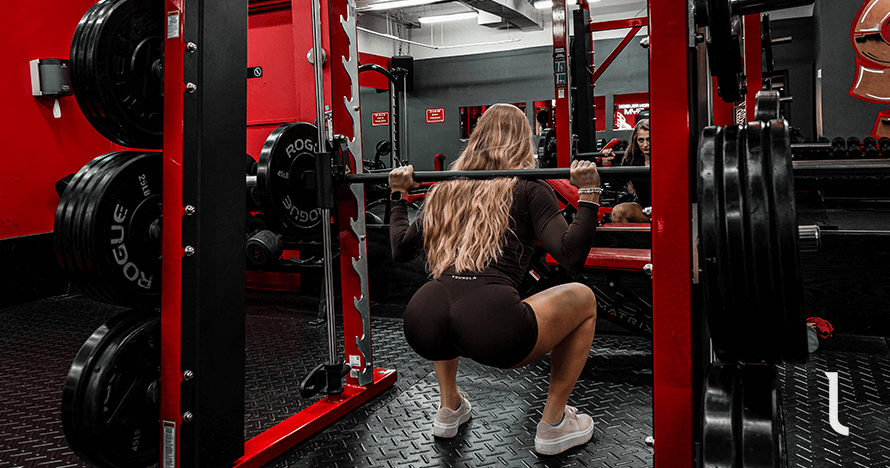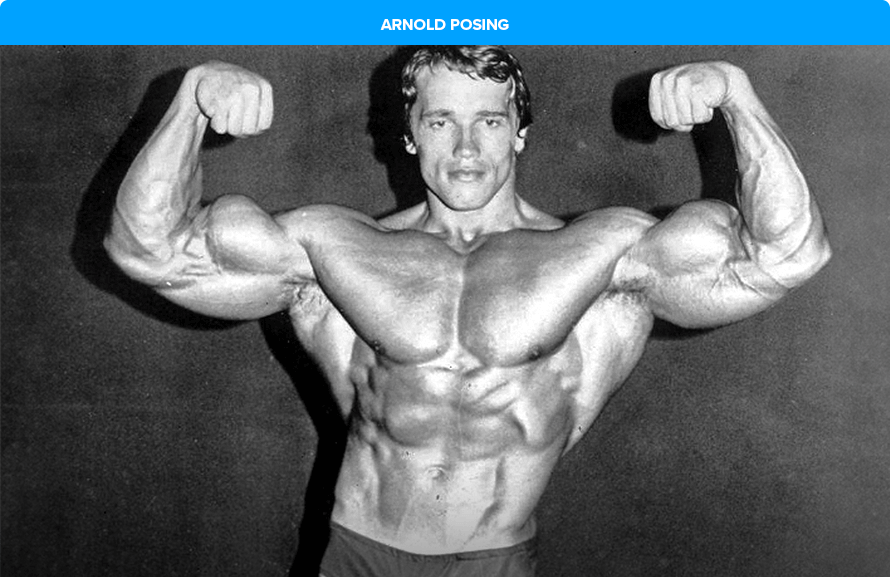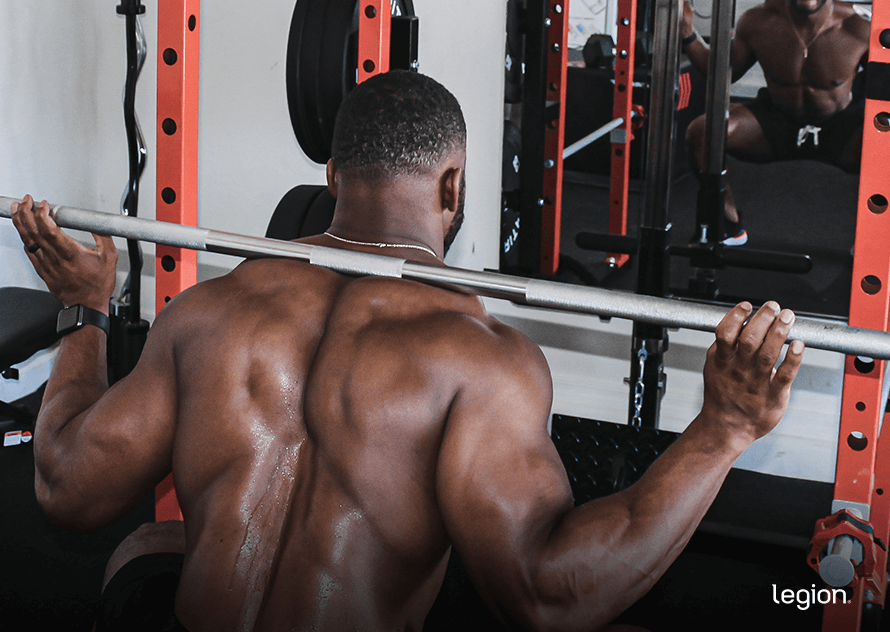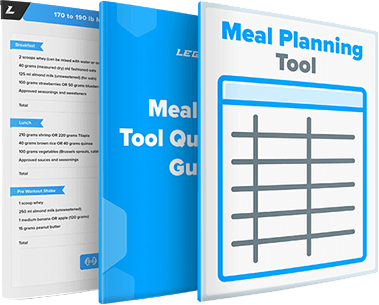The Arnold split is a 6-day training routine where you do workouts for your chest and back, shoulders and arms, and legs and lower back twice per week.
It was created by seven-time Mr. Olympia winner Arnold Schwarzenegger, and many hail it as the ultimate blueprint for building muscle mass.
But what is the Arnold split exactly? What are its pros and cons? And should you follow it?
Get evidence-based answers to these questions and more in this article.
Want to know exactly how you should train to reach your fitness goals? Take our free 60-second training quiz and find out now.
Key Takeaways
- The Arnold split is a 6-day training routine that involves doing workouts for your chest and back, shoulders and arms, and legs and lower back twice per week.
- To get the best results, Arnold recommended getting progressively stronger over time and training to failure through a full range of motion.
- The pros of the Arnold split are that it emphasizes compound exercises for the entire body and progressive overload. Its main drawbacks are that it’s time-consuming, unsuitable for beginners, and some of the principles aren’t supported by science.
- To accelerate your progress on the Arnold split workout program, use a high-quality protein powder to hit your daily protein target, creatine to boost recovery and growth, and a pre-workout to enhance energy, focus, and performance.
- If you don’t like repeating the same workouts twice weekly but still want to train like Arnold, the PPL x Arnold split hybrid routine is a good solution.
Table of Contents
+
What Is the Arnold Split?

The Arnold split is a high-volume, 6-day bodybuilding workout routine designed by Arnold Schwarzenegger to maximize muscle growth.
Technically, when people refer to the Arnold split, they’re usually talking about one of the two “basic” routines that Arnold outlined in his 1985 book, The New Encyclopedia of Modern Bodybuilding—specifically, his “Level 1” program.
Despite being labeled “basic,” this routine is not for beginners—many experienced gymgoers find it challenging.
The second level of the basic program and the two “advanced” programs are even more demanding, to the point that they’re often unrealistic for most natural weightlifters.
The Arnold Split Workout Routine: Weekly Schedule

The Arnold split contains three separate workouts: chest and back; shoulders, upper arms, and forearms; and thighs (quad and hamstrings), calves, and lower back.
You repeat these workouts twice weekly for a total of six training sessions. Here’s the basic layout:
- Day 1: Chest and back
- Day 2: Shoulders, upper arms, and forearms
- Day 3: Thighs, calves, and lower back
- Day 4: Chest and back
- Day 5: Shoulders, upper arms, and forearms
- Day 6: Thighs, calves, and lower back
- Day 7: Rest
You also train your abs in every workout.
Now, let’s look at how to perform each workout:
Day #1: Chest and Back
Arnold’s chest day isn’t like most bodybuilding chest workouts. Instead of training only the pecs, he liked to train his chest alongside his back (often using “supersets”). For him, this was the best way to improve conditioning and maximize “the pump:”
- Flat Barbell Bench Press: 4 sets x 15, 10–12, 8–10, 6 reps
- Incline Barbell Bench Press: 4 sets x 15, 10–12, 8–10, 6 reps
- Dumbbell Pullover: 4 sets x 15, 10–12, 8–10, 6 reps
- Chin-up: 50 total reps
- Barbell Row: 4 sets x 15, 10–12, 8–10, 6 reps
- Deadlift: 3 sets x 10, 6, 4 reps (to failure)
- Crunch: 5 sets x 25 reps
Day #2: Shoulders, Upper Arms, and Forearms
Day 2 of the Arnold split is a mammoth workout that trains all three “heads” of your deltoids and your entire arm:
- Clean and Press (or Overhead Press): 4 sets x 15, 10–12, 8–10, 6 reps
- Dumbbell Side Lateral Raise: 4 sets x 15, 10–12, 8–10, 6 reps
- Upright Row: 3 sets x 10, 6, 4 reps (to failure)
- Push Press: 3 sets x 10, 6, 4 reps (to failure)
- Barbell Curl: 4 sets x 15, 10–12, 8–10, 6 reps
- Dumbbell Curl: 4 sets x 15, 10–12, 8–10, 6 reps
- Close-Grip Bench Press: 4 sets x 15, 10–12, 8–10, 6 reps
- Overhead Triceps Extension: 4 sets x 15, 10–12, 8–10, 6 reps
- Wrist Curl: 4 sets x 15, 10–12, 8–10, 6 reps
- Reverse Wrist Curl: 4 sets x 15, 10–12, 8–10, 6 reps
- Reverse Crunch: 5 sets x 25 reps
Day #3: Thighs, Calves, and Lower Back
Day 3 of the Arnold split is a rigorous lower body workout focusing on the quads, hamstrings, calves, and lower back—areas Arnold believed were critical for a well-balanced physique:
- Squat: 4 sets x 15, 10–12, 8–10, 6 reps
- Lunge: 4 sets x 15, 10–12, 8–10, 6 reps
- Leg Curl: 4 sets x 15, 10–12, 8–10, 6 reps
- Standing Calf Raise: 5 sets x 15 reps
- Stiff-Leg Deadlift: 3 sets x 10, 6, 4 reps (to failure)
- Good Morning: 3 sets x 10, 6, 4 reps (to failure)
- Crunch: 5 sets x 25 reps
Arnold Split Training Principles: How to Train Like Arnold

To maximize your results on Arnold Schwarzenegger’s workout routine, he recommends following these principles:
- Progressive Overload: Arnold emphasizes progressive overload (gradually increasing the weight you lift over time), which is the primary driver of muscle growth. The easiest way to implement this is to use double progression.
- Training to Failure: Arnold advises pushing each set to the point where you cannot perform another rep without resting (“failure”). He believes this maximizes muscle fiber stimulation and growth.
- Full Range of Motion: To fully activate every muscle fiber, Arnold recommends performing each exercise through its entire range of motion, from fully stretched to fully contracted.
- Quality of Contraction: Arnold emphasizes the importance of focusing on how well you contract your muscles during every rep. He suggests starting with lighter weights that allow precise, controlled movements, ensuring the target muscle does most of the work without help from surrounding muscles.
- Warming Up: While Arnold considers warming up essential for preventing injuries, he doesn’t specify a strict warm-up routine. Instead, he suggests general light barbell or dumbbell exercises for each body part, followed by a light set of each exercise in your workout before you begin your heavier training.
- Power Training: In Arnold’s regimen, “power training” involves lifting weights near your one-rep max. He believes power training is important because it builds “dense” muscle that’s easy to maintain, increases muscle and tendon strength, prevents injuries, and builds mental toughness.
- Rest Between Sets: Arnold recommends keeping rest periods between sets to a minute or less. According to him, short rest periods allow you to recover most of your strength while ensuring your muscle fibers are fatigued enough to necessitate growth.
Benefits of the Arnold Split Workout Routine

The Arnold split stands out from many traditional bodybuilding routines thanks to a few features that make it especially effective for muscle growth.
Balanced Exercise Selection
The Arnold split primarily comprises compound exercises (exercises involving multiple joints and muscles). Focusing on compound exercises is beneficial because they allow you to train dozens of muscles simultaneously and lift heavy weights safely, which is generally better for muscle and strength gain.
The Arnold split also contains a reasonable amount of isolation exercises (exercises involving just one joint and muscle). Adding isolation exercises to your workout routine is sensible because they allow you to continue training a muscle when it’s no longer practical to do so with a compound exercise.
They also allow you to train through different ranges of motion, which likely produces more complete growth than only doing compound exercises.
Focus on Progressive Overload
Many bodybuilding programs make minor aspects of muscle growth the focus of your training. For example, they encourage you to train your muscles until they are swollen, pumped, and sore despite evidence that these aren’t particularly reliable indicators of muscle growth.
In contrast, the Arnold split prioritizes getting progressively stronger over time, which is paramount for gaining muscle and strength. In other words, the Arnold split highlights what really matters when it comes to building muscle.
Optimal Training Frequency
Many bodybuilding workout splits organize workouts by body part—they train your chest on one day, your back on the next, your shoulders the day after, and so forth.
This usually means you train each body part just once per week, which research shows isn’t as effective as training your muscles more frequently.
On the other hand, the Arnold split trains each muscle group at least twice per week, which is typically better for muscle-building purposes.
Drawbacks of the Arnold Split Workout Routine

The Arnold split can work well, but it’s not for everyone. If you’re short on time, new to strength training, or want a science-backed routine, here are some important downsides to consider.
Time-Consuming
The Arnold split has you training 6 days per week, and each workout is lengthy, comprising between 7 and 11 exercises.
When your workout routine requires such a significant time commitment, it can be challenging to maintain, especially if you have limited time for training.
Not Beginner-Friendly
The volume (number of sets) and frequency (number of weekly workouts) in the Arnold split are unnecessary for beginners; doing fewer sets less often will likely yield better results.
Arnold also advocates advanced training methods in his book—drop sets, negative reps, forced reps, and so on—which add a layer of complexity that’s unnecessary and potentially confusing for novices.
Lacking Scientific Backing
Certain aspects of the Arnold split, such as training to failure, short rest periods, and extensive warm-ups, lack scientific support.
While these methods may be effective in some scenarios, research shows training shy of failure, taking plenty of rest, and doing short but adequate warm-ups are superior for gaining muscle and strength.
Is the Arnold Split Effective for Building Muscle?
Yes—the Arnold split can be highly effective for building muscle if you’re an experienced weightlifter who can recover from intense training.
It emphasizes the fundamentals of hypertrophy: heavy compound weightlifting, progressive overload, and training each muscle group at least twice per week.
That said, it has some fairly notable downsides. To minimize these, here are a few adjustments:
- Rest 3-to-5 minutes between big compound exercises like squats and deadlifts, and 2-to-3 minutes between smaller compounds and isolation exercises.
- Stop 1-to-3 reps shy of failure on most sets.
- Warm up with a few progressively heavier low-rep sets of the first exercise in your workout. For example, before your leg workout, do 6 reps at ~50% of your 1-rep max, rest 1 minute, then 4 reps at ~70%, rest 1 minute, then begin your workout.
- Lower the overall training volume by reducing the number of sets you do for each exercise by one (e.g., if it says do 4 sets, do 3; if it says do 3, do 2).
Who Should Follow the Arnold Split?
The Arnold split is best suited to intermediate and advanced weightlifters who have at least a year of consistent training under their belt, eat enough calories and protein to support intense training and recovery, and have the time and energy to train six days per week.
Many people see pictures of Arnold posing in his prime and think the Arnold split will help them achieve a similar physique. Case in point:

It’s sensible to temper these expectations, though. Beginners won’t get good results from the Arnold split—the volume, intensity, and frequency are too high and will likely lead to burnout rather than progress.
Unless your training, diet, and sleep are dialed in, you’re better off with a simpler, less demanding program.
Best Supplements for the Arnold Split Workout Routine
If you follow the Arnold split routine, consider these three supplements to maximize growth, train hard, and recover faster:
- Protein powder: Protein powder, such as Whey+ (Legion’s whey isolate) or Casein+ (Legion’s micellar casein), provides your body with the nutrients needed to build muscle tissue and recover from your workouts.
- Creatine: Creatine boosts muscle and strength gain, improves anaerobic endurance, and reduces muscle damage and soreness from your workouts. For a natural source of creatine, try Legion’s creatine monohydrate, creatine gummies, or post-workout Recharge.
- Pre-workout: A high-quality pre-workout enhances energy, mood, and focus, increases strength and endurance, and reduces fatigue. For a top-tier pre-workout containing clinically effective doses of 6 science-backed ingredients, try Legion’s Pulse with caffeine or without.
(If you’d like even more specific advice about which supplements you should take to reach your health and fitness goals, take the Legion Supplement Finder Quiz, and in less than a minute, you’ll know exactly what supplements are right for you.)
PPL x Arnold Split Hybrid: An Alternative to the Arnold Split

One popular alternative to the Arnold split is the PPL x Arnold split—a 6-day training routine that combines push pull legs (PPL) with Arnold Schwarzenegger’s workout routine. Here’s how it often looks:
- Day 1: Chest and back
- Day 2: Shoulders, upper arms, and forearms
- Day 3: Thighs, calves, and lower back
- Day 4: Push
- Day 5: Pull
- Day 6: Legs
- Day 7: Rest
PPL x Arnold split routines have become popular in recent years, primarily because people on Reddit and bodybuilding forums tout them as the perfect mix of bodybuilding and strength-focused training (“powerbuilding”).
While PPL x Arnold split routines can work, they typically come with the same challenges as regular 6-day PPL and Arnold splits: they require a significant time investment, and if you don’t have your diet and recovery dialed in, they’re overkill for most people.
Still, if you’re an intermediate or advanced weightlifter who meets the criteria for following the Arnold split but would prefer more variation throughout the week, the PPL x Arnold hybrid might be a good fit.
READ MORE: The Ultimate Guide to the Push Pull Legs Workout Routine
FAQ #1: Is the Arnold split good for muscle growth?
Yes, the Arnold split can be highly effective for muscle growth for some people. Specifically, it works well for intermediate or advanced weightlifters (people with at least 12 months of consistent training under their belt) who have plenty of time to train, are eating enough calories and protein, and get plenty of rest.
However, a less intense training regimen is likely more fitting if you don’t meet these criteria.
READ MORE: The 12 Best Science-Based Strength Training Programs for Gaining Muscle and Strength
FAQ #2: Arnold Split vs. PPL: Which is better?
The 6-day PPL and Arnold splits share a lot in common: They involve training six days per week, train each body part at least twice weekly, emphasize compound weightlifting and progressive overload, and so on. Thus, choosing the right routine for you mostly depends on your preferences.
The Arnold split involves training your large upper body muscle groups (chest and back), smaller upper body muscles (shoulders, biceps, triceps, and forearms), and legs in separate workouts. If this approach works for you, choose the Arnold split.
If, on the other hand, you prefer to organize your training into “pushing,” “pulling,” and lower body exercises, PPL is likely better,
FAQ #3: How much should you eat while following the Arnold split?
To fuel your training while following the Arnold split, it’s sensible to follow a bulking diet (eat in a calorie surplus) and eat plenty of protein.
To learn exactly how many calories and how much protein you’d need to get results on the Arnold split, take the Legion Diet Quiz.
Scientific References +
- Schoenfeld, Brad J. “The Mechanisms of Muscle Hypertrophy and Their Application to Resistance Training.” Journal of Strength and Conditioning Research, vol. 24, no. 10, 2010, pp. 2857–72, https://doi.org/10.1519/JSC.0b013e3181e840f3.
- Kubo, Keitaro, et al. “Effects of Squat Training with Different Depths on Lower Limb Muscle Volumes.” European Journal of Applied Physiology, vol. 119, no. 9, 22 June 2019, https://doi.org/10.1007/s00421-019-04181-y.
- McLESTER, JOHN R., et al. “Comparison of 1 Day and 3 Days per Week of Equal-Volume... : The Journal of Strength & Conditioning Research.” LWW, 2019, journals.lww.com/nsca-jscr/Abstract/2000/08000/Comparison_of_1_Day_and_3_Days_Per_Week_of.6.aspx.
- Crewther, Blair, et al. “The Effects of Two Equal-Volume Training Protocols upon Strength, Body Composition and Salivary Hormones in Male Rugby Union Players.” Biology of Sport, vol. 33, no. 2, 6 Mar. 2016, pp. 111–116, www.ncbi.nlm.nih.gov/pmc/articles/PMC4885621/, https://doi.org/10.5604/20831862.1196511.
- Stokes, Tanner, et al. “Recent Perspectives Regarding the Role of Dietary Protein for the Promotion of Muscle Hypertrophy with Resistance Exercise Training.” Nutrients, vol. 10, no. 2, 7 Feb. 2018, p. 180, www.mdpi.com/2072-6643/10/2/180/pdf.
- Eckerson, Joan M., et al. “Effect of Creatine Phosphate Supplementation on Anaerobic Working Capacity and Body Weight after Two and Six Days of Loading in Men and Women.” The Journal of Strength and Conditioning Research, vol. 19, no. 4, 2005, p. 756, https://doi.org/10.1519/r-16924.1.
- Bassit, Reinaldo Abunasser, et al. “Effect of Short-Term Creatine Supplementation on Markers of Skeletal Muscle Damage after Strenuous Contractile Activity.” European Journal of Applied Physiology, vol. 108, no. 5, 3 Dec. 2009, pp. 945–955, https://doi.org/10.1007/s00421-009-1305-1.










